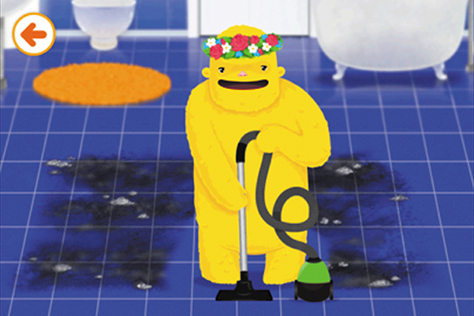The other parent let her 3-year-old daughter play games and watch videos on the iPad whenever she wanted. Her favorite game was Angry Birds. She explained how her little girl was frustrated in the beginning because she could only launch the birds backward, but that she had finally figured out how to turn the slingshot around and launch the birds toward the targets. This mother talked about how excited her daughter was when she knocked over the pigs and was able to really “play” the game as intended. The mother also noticed significant progress in her daughter’s hand-eye coordination. At the time, the other mother of the boy shook her head in disapproval, clearly disagreeing with playtime or watching videos on an iPad.
So Which Is It? Playing or Learning?
Is one of these parents right and the other wrong? Maybe. Despite a multitude of studies done about kids and screen time, no one really knows what effects TV and interactive media will have on their development. What we do know, however, is that both kids described in the previous example are playing and learning. Whether they’re learning reading and math through traditional teaching principles, or physics and hand-eye coordination through games, they’re learning concepts, skills, and strategies that will ultimately serve them in life. They’re also developing new schema for interpreting the world around them.
It’s easy to lose sight of the fact that kids learn and communicate through play. As a designer, you’re responsible for understanding your audience and creating experiences based on the way that people prefer to complete tasks. However, as a designer for kids, you’re responsible for understanding that kids prefer to complete their tasks, such as learning, through play.
Unfortunately, education systems in many countries throughout the world have taught us that playing and learning are separate activities—one is conducted in a classroom setting, and the other on a playground. In fact, every time designers mention the importance of play when designing for kids, they usually counter it with this thought, “But I want to create something educational, to help kids learn. I don’t want to make just another game.”
In actuality, the most successful kids’ sites and games do have learning at their core. Games like Angry Birds and Where’s My Water teach complex physics principles to children as young as age 5. Sites like Webkinz and Club Penguin teach currency, philanthropy,2 and money management. And apps such as Toca Band and Baby Piano teach the basics of music composition. The key difference between these experiences and more traditional “learning” games is that they put play front and center. The educational aspect, even though it’s the primary goal, takes almost a backseat for kids as they strive to master the complex machinations of the game.
Designing for Kids vs. Designing for Adults
You now know that designing for kids is different from designing for adults. But how is it different? Actually, the differences are much more subtle and nuanced than people thought just a few years ago. When you are designing for adults—even when designing games for adults—the goal is to help them cross the finish line. When you are designing for children, the finish line is just a small part of the story. Here are some key differences to consider:
- Challenge
- Feedback
- Trust
- Change
Challenge
Kids delight in challenge and conflict, regardless of their goals. Adults, when they are trying to accomplish routine tasks like checking their account balances or reading email, don’t. Toca Boca, a Swedish company that makes wonderful apps for preschool and elementary-aged kids, nails this concept with its Toca House iPad game (see Figure 2.1). In this game, kids have to clean a rug by swiping a vacuum cleaner over it. Instead of making the dirt disappear after a single swipe, the Toca Boca design team created a more challenging interaction, where the dirt fades slowly with each swipe. While this ongoing friction would drive adults nuts, kids love it. According to Toca Boca company cofounder Emil Ovemar, profiled at the end of Chapter 4, the added challenge makes the accomplishment more significant for kids, and also makes the app feel more exciting and fun.
Conflict is important for adults, too, but at a more macro level. Conflict in movies and in games for adult audiences helps move the story along, but for kids, little micro-conflicts, like cleaning up a dirty rug, help them resolve their own inner conflicts. LEGO did an interesting study on “conflict play” where it determined that conflict helps “…youngsters develop skills such as:
- Predicting how others are likely to react to their behavior
- Controlling their own emotions
- Communicating clearly
- Seeing other people’s points of view
- Creatively resolving disagreements”

Feedback
Kids love visual and auditory feedback whenever they do anything in a digital space. If you open any site or app that is designed for kids, you’ll see that every interaction produces some sort of response or reaction. On the other hand, adults like to get feedback at the point of success, or when they do something wrong. Unlike kids, adults tend to get annoyed when every movement of the mouse or every gesture on a mobile device results in a sound or animation. Imagine if you were trying to balance your checkbook online, and every time you entered a number or clicked the “return” key, you heard applause and saw a little animation. You’d be pretty annoyed, right? Not kids. They like to be rewarded for everything they do.
Trust
Kids are much more trusting than adults, generally speaking, because they are unable to see or understand the ramifications of their actions ahead of time. Kids can be taught not to talk to strangers online or give out personal data to people they don’t know, but unless something bad happens as a result, they can’t fully anticipate the results of what they do online. This behavior continues through the teenage years, and it explains the risky behavior of teens both on- and offline.
In 2007, Laurence Steinberg, PhD, of Temple University, concluded that the slow maturation of the cognitive-control system, which is responsible for impulse control, could lead to risky behavior in kids between puberty and adulthood.4 While apps like Facebook, which allow kids 13 and older to participate, don’t actively encourage risk-taking, they do very little to prevent trusting children from “friending” people they don’t know. As designers, you are responsible for understanding this trust issue and build safeguards to protect your young users (see Chapter 6 for more information).
Change
As anyone knows, kids change pretty quickly, so when you design for a 3-year-old, you know that the app you’re designing probably won’t work for a 6-year-old. Consequently this book is broken into two-year age increments, so you’ll be able to understand these differences and the implications they present for design.
I was once asked to design a website for kids ages 6-11, which is a ridiculously large age range. I ended up designing levels, not to limit children’s play but to allow them to access content and activities appropriate for them. It worked, but my preference would have been to focus on a much smaller age range to increase usage and appeal.
Adults, on the other hand, are generally pretty consistent in terms of cognitive capacity, so they aren’t apt to change as frequently as children.
The Similarities Between Kids and Adults
Even with these differences, it’s important to note that there are quite a few similarities between designing for kids and designing for adults. These include the following:
- Consistency
- Purpose
- Surprise
- Lagniappe
Consistency
When designing apps, make sure that your design patterns are consistent. Both kids and adults get annoyed by design elements that seem random and unnecessary. A common misperception about designing for kids is that they like everything on the screen to do something cool. In fact, it’s quite the opposite. Children like items on a screen to do cool stuff as long as there is a method to the proverbial madness.
Elements that get in the way or animate spontaneously or don’t contribute to the overall goal can frustrate kids and adults alike, and cause them to abandon a game or an app entirely. In addition, if everything on the screen moves, is brightly colored, or makes noise on the same level, kids and adults become confused about what is interactive and what isn’t, and this makes it very hard for them to use the site or app. A common design principle for adults is to keep interactions and feedback consistent so that users will be able to learn how use the site or app quickly. The same is true for kids.
Purpose
Kids, like adults, need a reason to use a site or an app, and they need this reason to be evident right from the start. While kids will be more open to exploring and learning than adults, they’ll get bored quickly if they are not immediately engaged in the goals and purpose.
For example, if it’s a game, will it be fun? If it’s a tool, what will it help them do or learn? They need to know what’s in it for them before they’re willing to fully engage. This doesn’t necessarily mean that you have to create detailed explanations or how-to videos, but it does mean that you have to communicate clearly what your app is and how it works before users have time to decide they’re not interested.
Surprise
Both kids and adults develop expectations around how a site or app will behave, and they like to have those expectations met. Neither kids nor adults are particularly interested in being surprised, or in having an experience deviate from how they expect it to work.
As an adult making a purchase online, after you submit your payment, you expect to see a message confirming your purchase, not a pop-up ad with a video trying to sell you something else. As a kid adding gems to a box in a game, you expect to be able to open the box where the gems are stored to see them all, not to have to open the box, pull out drawers, and hunt for the stuff you thought was in there.
Lagniappe
I first heard the word lagniappe from my editor, Marta. A lagniappe is a little something extra—an “Easter egg”—thrown in to delight users or customers, and both adults and kids enjoy these small, unexpected interactions that enhance their experience with a site or app. For example, Twitter’s mobile “pull down to refresh” option shows a nice little animation, letting users know their feed is being updated. If kids leave the Talking Carl app open for a few minutes without interacting with it, it sings softly to itself to get their attention. It’s important to note that there is a difference between a “surprise” and an “unexpected delight,” however. A “surprise” is when the jack-in-the-box jumps out and scares the crap out of you. Lagniappes are the frozen grapes the hotel passes out while you’re overheating by the pool.
You’ll want to be aware of these differences and similarities when designing for kids. Remember that designing for children isn’t just a matter of taking content, images, and interactions meant for adult audiences and “dumbing them down.” You’ll need to make a conscious effort to understand where your users are cognitively, physically, and emotionally and make sure that your designs map to them appropriately. Conversely, if you look at designing for kids as completely different from designing for adults, you’ll lose sight of some of the key conventions and patterns that are hallmarks of good digital design.






